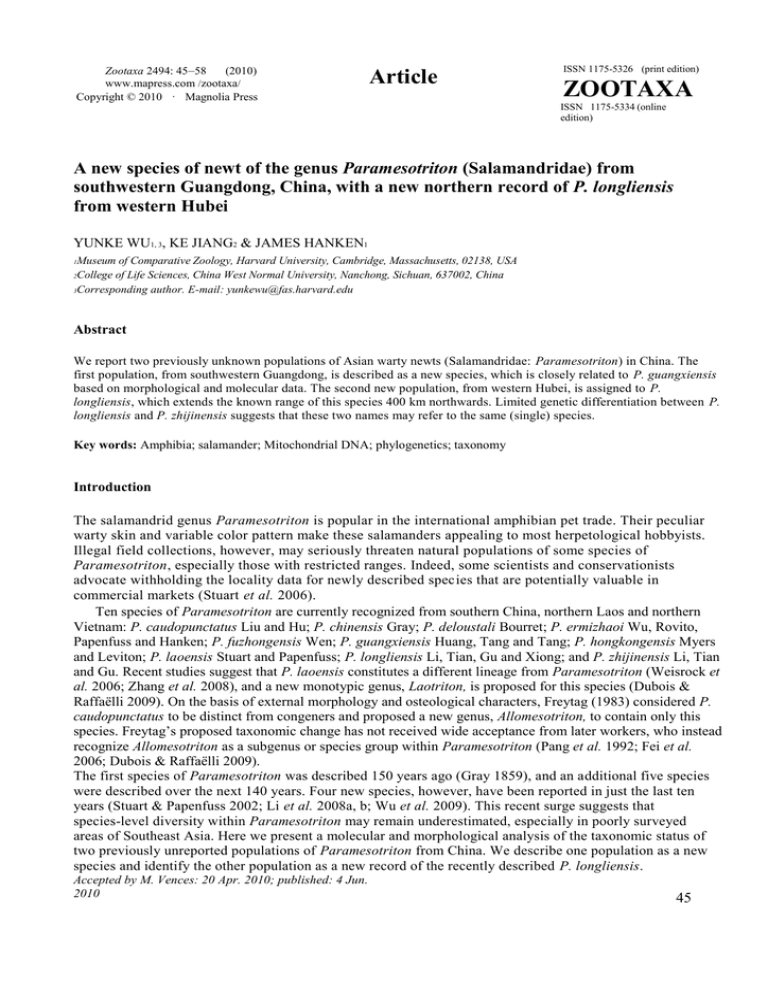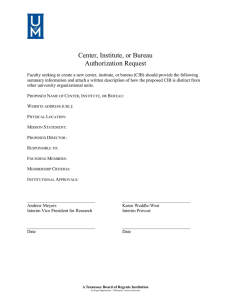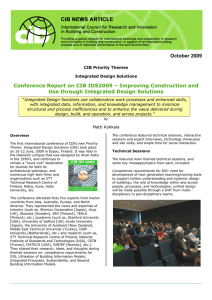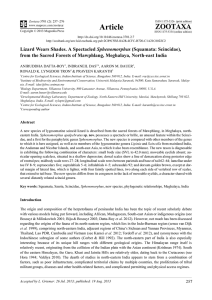ZOOTAXA Article Paramesotriton P. longliensis
advertisement

Zootaxa 2494: 45–58 (2010) www.mapress.com /zootaxa/ Copyright © 2010 · Magnolia Press Article ISSN 1175-5326 (print edition) ZOOTAXA ISSN 1175-5334 (online edition) A new species of newt of the genus Paramesotriton (Salamandridae) from southwestern Guangdong, China, with a new northern record of P. longliensis from western Hubei YUNKE WU1, 3, KE JIANG2 & JAMES HANKEN1 Museum of Comparative Zoology, Harvard University, Cambridge, Massachusetts, 02138, USA College of Life Sciences, China West Normal University, Nanchong, Sichuan, 637002, China 3Corresponding author. E-mail: yunkewu@fas.harvard.edu 1 2 Abstract We report two previously unknown populations of Asian warty newts (Salamandridae: Paramesotriton) in China. The first population, from southwestern Guangdong, is described as a new species, which is closely related to P. guangxiensis based on morphological and molecular data. The second new population, from western Hubei, is assigned to P. longliensis, which extends the known range of this species 400 km northwards. Limited genetic differentiation between P. longliensis and P. zhijinensis suggests that these two names may refer to the same (single) species. Key words: Amphibia; salamander; Mitochondrial DNA; phylogenetics; taxonomy Introduction The salamandrid genus Paramesotriton is popular in the international amphibian pet trade. Their peculiar warty skin and variable color pattern make these salamanders appealing to most herpetological hobbyists. Illegal field collections, however, may seriously threaten natural populations of some species of Paramesotriton, especially those with restricted ranges. Indeed, some scientists and conservationists advocate withholding the locality data for newly described species that are potentially valuable in commercial markets (Stuart et al. 2006). Ten species of Paramesotriton are currently recognized from southern China, northern Laos and northern Vietnam: P. caudopunctatus Liu and Hu; P. chinensis Gray; P. deloustali Bourret; P. ermizhaoi Wu, Rovito, Papenfuss and Hanken; P. fuzhongensis Wen; P. guangxiensis Huang, Tang and Tang; P. hongkongensis Myers and Leviton; P. laoensis Stuart and Papenfuss; P. longliensis Li, Tian, Gu and Xiong; and P. zhijinensis Li, Tian and Gu. Recent studies suggest that P. laoensis constitutes a different lineage from Paramesotriton (Weisrock et al. 2006; Zhang et al. 2008), and a new monotypic genus, Laotriton, is proposed for this species (Dubois & Raffaëlli 2009). On the basis of external morphology and osteological characters, Freytag (1983) considered P. caudopunctatus to be distinct from congeners and proposed a new genus, Allomesotriton, to contain only this species. Freytag’s proposed taxonomic change has not received wide acceptance from later workers, who instead recognize Allomesotriton as a subgenus or species group within Paramesotriton (Pang et al. 1992; Fei et al. 2006; Dubois & Raffaëlli 2009). The first species of Paramesotriton was described 150 years ago (Gray 1859), and an additional five species were described over the next 140 years. Four new species, however, have been reported in just the last ten years (Stuart & Papenfuss 2002; Li et al. 2008a, b; Wu et al. 2009). This recent surge suggests that species-level diversity within Paramesotriton may remain underestimated, especially in poorly surveyed areas of Southeast Asia. Here we present a molecular and morphological analysis of the taxonomic status of two previously unreported populations of Paramesotriton from China. We describe one population as a new species and identify the other population as a new record of the recently described P. longliensis. Accepted by M. Vences: 20 Apr. 2010; published: 4 Jun. 2010 45 Material and methods Nine specimens from the first new population were collected from streams on Yunwu Mountain in southwestern Guangdong. Seven specimens from the second population were caught by seine net from a river in Xianfeng County, western Hubei. Euthanized newts were fixed and preserved in 75% ethanol. Freshly cut liver samples from each animal were preserved in 100% ethanol for molecular analyses. We took the following linear measurements from preserved specimens with a digital caliper: TTL, total length; SVL, snout-vent length, measured from the tip of the snout to the posterior edge of the vent; TAL, tail length, measured from the posterior edge of the vent to the tail tip; TAD, maximum tail depth; HL, head length, measured from the tip of the snout to the posterior edge of the parotoid gland; HW, maximum head width; IO, interocular distance, measured from the anterior corner of each eye; EN, distance from the anterior corner of the right eye to the right nostril; IN, internostril distance; AG, distance between the axilla and the groin along the left side of the body; AL, average length of both forelimbs; PL, average length of both hind limbs. Osteological features were assessed by dissection and digital radiography at the Museum of C omparative Zoology, Harvard University (MCZ). Material for morphological comparisons was examined from the Chengdu Institute of Biology, Chinese Academy of Sciences (CIB), the Museum of Vertebrate Zoology, University of California at Berkeley (MVZ), and the Kunming Institute of Zoology, Chinese Academy of Sciences (KIZ). We also incorporated data from the original descriptions of previously named species. Phylogenetic relationships of the two new populations of Paramesotriton to congeneric species were derived from molecular genealogical reconstruction based on the mitochondrial ND2 fragment and flanking tRNAs. This work extended the analysis of Wu et al. (2009). Sequences were generated or retrieved from GenBank for all known species (Table 1) except P. laoensis, which exhibits closer affinity to the sister genus Pachytriton—our phylogenetic outgroup—than to other Paramesotriton on the basis of a mitogenomic analysis (Zhang et al. 2008). All taxa were sampled from or near their respective type localities (Fig. 1, Table 1). Genomic DNA extraction, PCR and sequencing methods were performed as in Wu et al. (2009); PCR primers were available from Wu et al. (2010). Mitochondrial sequences were aligned manually in Se-Al 2.0 (Rambaut 1995). No premature stop codons or indels were found in the protein-coding region. We inferred the matriarchal genealogical relationships within Paramesotriton using both maximum likelihood (ML) and Bayesian inference (BI) methods. The optimal evolutionary model was determined by the Akaike Information Criterion (AIC) implemented in MODELTEST 3.7 (Posada & Crandall 1998); the ML analysis was conducted in Garli v.0.951 (Zwickl 2006). The search for the ML tree was continued until the ML had not been improved by 0.01 for 500,000 generations. Bootstrap values were calculated for 100 replicates with the termination threshold reduced to 100,000 generations. Bayesian inference was executed in MrBayes 3.1.2 (Huelsenbeck & Ronquist 2001). Sequence data were partitioned according to tRNA and codon positions because a mitogenomic study on plethodontid salamanders suggests significant improvement of model likelihoods by defining more partitions (Muller et al. 2004). Independent GTR+I+G models were assigned to each data partition. Two independent runs with three heated chains and one cold chain were carried out for four million generations. Parameter convergence was assessed by the average standard deviation of split frequencies. The first two million generations were discarded as burn-in. To assess the effect of data partitioning on nodal support, we also conducted an unpartitioned analysis, which, with other conditions unchanged, applied one GTR+I+G model to the entire mtDNA sequence. Harmonic means of model likelihood were compared between the partit ioned and unpartitioned strategy using Bayes Factor (BF). A BF > 10 indicates strong evidence favoring the better model (Kass & Raftery 1995). Additionally, we performed a maximum parsimony (MP) analysis in PAUP* 4.0b10 (Swofford 2002). A heuristic search was carried out for 1000 random-sequence-addition replicates; the MP bootstrap support was calculated by 1000 nonparametric pseudo-replicates. Interspecific divergences were assessed through uncorrected pairwise genetic distances (p-distance) in PAUP*; sequences retrieved from Lu et al. (2004) were excluded due to the large amount of missing data. WU ET AL.46 · Zootaxa 2494 © 2010 Magnolia Press FIGURE 1. Sample localities. 1: Paramesotriton sp. (western Hubei); 2: P. caudopunctatus; 3: P. zhijinensis; 4: P. longliensis; 5: P. chinensis; 6: P. hongkongensis; 7: P. ermizhaoi; 8: P. fuzhongensis; 9: P. guangxiensis; 10: P. deloustali. Asterisk (11) denotes the type locality of P. yunwuensis sp. nov. The Yunwu Mountains are shaded orange. Inset: red square shows the focal area in Asia. Results and discussion Mitochondrial ND2 and flanking tRNA sequences yield an alignment for 33 specimens that contains 1216 nucleotide sites; 432 of these are variable and 356 are potentially parsimony-informative. Two single-site indels at the tRNA-Trp region are present in the sequences from Pachytriton (outgroup), and a single-site deletion is fixed at the tRNA-Ala region in the new population of Paramesotriton from southwestern Guangdong. TrN+G is the optimal evolutionary model for the ML analysis (alpha = 0.2876). Branch lengths from BI are unrealistically long (nearly ten times longer than those from ML), which results from the dependence of branch length estimation on branch length prior (Marshall 2010). Deleting sequences that contain a large amount of missing data or reducing the number of partitions ameliorates the long -branch problem. The partitioned-BI yields very similar posterior probabilities compared to the unpartitioned analysi s. But the partitioned strategy is strongly favored (BF = 436.36). Tree topologies from the ML, BI (partitioned and unpartitioned) and MP analyses are fully congruent. Therefore, we depict only the ML tree here (Fig. 2). Zootaxa 2494 © 2010 Magnolia Press · 47 A NEW PARAMESOTRITON FROM CHINA TABLE 1. Specimens included in the molecular phylogenetic analysis. Reference Species Voucher no. Locality GenBank acc. no. Ingroup Paramesotriton yunwuensis CIB 97854 Luoding, Guangdong, China GU980579 this study CIB 97855 Luoding, Guangdong, China GU980577 this study CIB 97856 Luoding, Guangdong, China GU980578 this study MVZ 220905 Ningming, Guangxi, China* DQ517804 Weisrock et al. (2006) Paramesotriton SN 02053 Ningming, Guangxi, China* AY233166 Lu et al. (2004) guangxiensis Paramesotriton fuzhongensis unknown unknown FJ169604 GenBank direct submission MVZ 230363 Xiling, Guangxi, China DQ517803 Weisrock et al. (2006) SN 02011 Fuchuan, Guangxi, China AY233162 Lu et al. (2004) unknown unknown FJ169605 GenBank direct submission Paramesotriton deloustali MVZ 223627 Tam Dao, Vinh Phu, Vietnam* DQ517802 Weisrock et al. (2006) MVZ 223628 Tam Dao, Vinh Phu, Vietnam* FJ744599 Wu et al. (2009) MVZ 223629 Tam Dao, Vinh Phu, Vietnam* FJ744600 Wu et al. (2009) Paramesotriton chinensis CIB 95899 Ningbo, Zhejiang, China* FJ744603 Wu et al. (2009) CIB 95911 Jinhua, Zhejiang, China FJ744604 Wu et al. (2009) CIB 95910 Jinhua, Zhejiang, China FJ744605 Wu et al. (2009) MVZ 230366 Hongkong, China* GU980581 this study Paramesotriton MVZ 230368 Hongkong, China* GU980582 this study hongkongensis CIB 97898 Huizhou, Guangdong, China GU980580 this study Paramesotriton ermizhaoi CIB 88140 Jinxiu, Guangxi, China* FJ744602 Wu et al. (2009) CIB 88141 Jinxiu, Guangxi, China* FJ744601 Wu et al. (2009) MVZ 230616 Jinxiu, Guangxi, China* DQ517801 Weisrock et al. (2006) Paramesotriton longliensis KIZ-GZH 081025 Longli, Guizhou, China* GU980576 this study unknown unknown FJ169608 GenBank direct submission Paramesotriton zhijinensis KIZ-GZH 081026 Zhijin, Guizhou, China* GU980575 this study unknown unknown FJ169609 GenBank direct submission Paramesotriton sp. CIB 97881 Xianfeng, Hubei, China GU980572 this study continued to next page... WU ET AL.48 · Zootaxa 2494 © 2010 Magnolia Press TABLE 1 (continued) Species Voucher no. Locality GenBank acc. no. Reference CIB 97883 Xianfeng, Hubei, China GU980573 this study CIB 97885 Xianfeng, Hubei, China GU980574 this study MVZ 236250 Leishan, Guizhou, China* DQ517799 Weisrock et al. (2006) Paramesotriton caudopunctatus O MVZ 236252 Leishan, Guizhou, China* EU880326 Zhang et al. (2008) u t g r o u Pachytriton archospotus CIB 95949 Guidong, Hunan, China* GQ303630 Wu et al. (2010a) p Pachytriton brevipes CIB 95926 Nanfeng, Jiangxi, China* GQ303626 Wu et al. (2010a) Pachytriton labiatus CIB 95946 Jinxiu, Guangxi, China* GU980583 this study * Type locality Monophyly of the genus Paramesotriton excluding P. laoensis is strongly supported. This result is congruent with Lu et al. (2004) and Weisrock et al. (2006). Moreover, each species represented by multip samples forms a single lineage. Paramesotriton comprises two reciprocally monophyletic groups. Basal relationships of group A are resolved only in the ML analysis, where they receive low statistical support, a the positions of P. ermizhaoi, P. chinensis and P. hongkongensis are ambiguous within this group. These three species constitute a single clade in Wu et al. (2009). The new population from southwestern Guangdong constitutes the sister taxon to P. guangxiensis. Together, they form the sister clade to P. fuzhongensis. Genetic divergences between the new population and P. guangxiensis and P. fuzhongensis a similar (4.04–4.21% and 3.95–4.29%, respectively) but they slightly exceed distances between P. guangxiensis and P. fuzhongensis (3.95–4.04%). Paramesotriton deloustali from northern Vietnam is mor divergent, with distances of 4.69– 4.94% to P. fuzhongensis, 5.38–5.68% to P. guangxiensis, and 5.11–5.52% to the population from southwestern Guangdong. These distances are generally lower than ot pairwise interspecific divergences within Paramesotriton, as well as those within the closely related gener Pachytriton and Cynops (Wu et al. 2009; Wu et al. 2010a, b). Nevertheless, these levels of divergence are comparable to those between some European salamandrids, such as Lissotriton montandoni and L. vulgari (Babik et al. 2005), and to those within true Triturus (Steinfartz et al. 2007). Even though the population from southwestern Guangdong, P. fuzhongensis, P. guangxiensis and P. deloustali resemble each other morphologically, each species can be diagnosed based on phenotypic characters (see below). Moreover, al sampled mitochondrial haplotypes from southwestern Guangdong have a unique single-site deletion near 3’-end of the tRNA-Ala sequence, which we regard as further evidence that this population is distinct from congeneric species. In doing so, we embrace an integrative taxonomy perspective (Padial et al. 2009) consistent with the view that each species is a metapopulation lineage that evolves separately from other such lineages (de Queiroz 2005, 2007). Group B in the matriarchal genealogy is well resolved and supported by all reconstruction methods. Paramesotriton caudopunctatus diverges early in the history of the clade, but recently described P. zhijinensis and P. longliensis are separated by only a modest genetic distance. Unexpectedly, the second ne population of Paramesotriton from western Hubei clusters with and is only slightly differentiated from P. longliensis (pdistance < 1.23%), despite the large geographic distance between sampling localities (ca. 400 km; Fig. 1). Both morphology and external coloration of this new population are consistent with the origina description of P. longliensis, although the new population has a distinct caudal coloration and occupies a different aquatic habitat (see below). Thus, we assign the western Hubei population to P. longliensis. Befor the description of Zootaxa 2494 © 2010 Magnolia Press · 49 A NEW PARAMESOTR ITON FROM CHINA P. longliensis (Li et al. 2008b), specimens of Paramesotriton were collected in southeastern Chongqing, which is geographically intermediate between western Hubei and the type locality o f P. longliensis in central Guizhou. These specimens, which were identified initially as P. chinensis (Xie et al. 2004), are morphologically similar to those from western Hubei and may belong to the same species. Therefore, the geographic range of P. longliensis likely extends from central Guizhou to western Hubei. FIGURE 2. Maximum-likelihood (ML) tree based on mitochondrial ND2 and flanking tRNA sequences. Bayesian inference (BI) and maximum parsimony (MP) analyses produced consistent but less -well-resolved topologies. Sequences without any museum numbers are from GenBank direct submissions. Paramesotriton sp. is the new population from western Hubei. Numbers on branches are MP bootstrap values; ML bootstrap values; Bayesian posterior probabilities. Asterisks indicate > 95% support in both MP and MP analyses and > 99% support in the partitioned-BI; double-dashes denote < 50% support. The sister genus Pachytriton (P. brevipes, P. archospotus and P. labiatus) is chosen as the outgroup taxon. WU ET AL.50 · Zootaxa 2494 © 2010 Magnolia Press Our DNA sequence data provide no evidence of long-term divergence between Paramesotriton longliensis and P. zhijinensis (p-distance < 1.84%). The most characteristic trait of P. zhijinensis is the presence of vestigial gills in breeding adults (Li et al. 2008a; Zhao et al. 2008). Close examination of cephalic morphology reveals that the same, likely neotenic trait is present both in P. longliensis from the type locality (Li et al. 2008b) and in specimens from western Hubei. Paramesotriton longliensis also shares with P. zhijinensis the presence of two non-continuous yellow dorsolateral stripes, although less conspicuous (only the dorsolateral warts are tinted yellow) in P. longliensis (Li et al. 2008b). Yellow dorsolateral stripes are a likely synapomorphy of group B, as they also are present in P. caudopunctatus (Fei et al. 2006). Limited genetic differentiation, similar phenotypes and short geographic distance between type localities (126 km; Fig. 1) constitute evidence against the recognition of P. longliensis and P. zhijinensis as distinct species. In conclusion, molecular phylogenetic analyses support recognition of a newly discovered population of Paramesotriton from southwestern Guangdong as a new species, which we describe below. A second population from western Hubei is interpreted as a geographically remote component of the recently described species P. longliensis. Paramesotriton yunwuensis species nov. (Fig. 3 A–G; Fig. 4) Holotype: CIB 97854, an adult male collected from a pool along a montane stream (22°37’N, 111°10’E; 525 m elevation) near Nanchong village, Fuhe, Luoding city, Guangdong province, P. R. China, by Yunke Wu and Ke Jiang on May 8, 2009. Paratypes: CIB 95336–95339, 97853, 97855–97856, 97950; same collection date and locality as the holotype. Diagnosis: Paramesotriton yunwuensis is assigned to the genus Paramesotriton by its phylogenetic position and the following characters: warts covering dorsal and lateral surfaces; bright orange blotches present on ventral surface; large body size; laterally compressed tail with rounded tip. This species can be diagnosed from congeners by a combination of adult characters: large body size; robust habitus, especially in males; head large and broad; corner of mouth located well posterior to caudal margin of eye; skin rough, warts cover dorsum of head and large warts on dorsolateral ridges; cephalic bony ridges present but not prominent; dorsal vertebral ridge flat to low, not highly protuberant; forelimb short, when extended anteriorly does not reach the caudal margin of eye; palm and tarsus of adpressed limbs do not overlap; tail long, but not deep; bright ventral blotches irregular without a network of black lines; males with bluish-white stripe on posterior half of tail in breeding season. Description of the holotype: This is a large newt; SVL equals 100.8 mm. Habitus very robust. Head large, much wider than neck. Head longer than broad. Snout truncate, projects beyond mandible. Head slopes steeply downward anteriorly in lateral view. Skull very broad; length / width = 1.06. Labial fold well developed on lateral side of upper jaw. Vomerine tooth patch ٨ -shaped; tooth rows converge anteriorly and extend slightly beyond anterior limit of choanae. Tongue elliptical, adheres to mouth floor but with free lateral margins. Frontosquamosal arch complete and robust. Posterior tip of maxillary bone articulates posteriorly with the pterygoid bone. Epibranchial bones elongated posteriorly and flared dorsolaterally. Parotoid gland prominent. Gular fold present, numerous longitudinal wrinkles on throat. Vertebral ridge flat and inconspicuous. Numerous transverse wrinkles on flanks, venter and lateral sides of tail base. Large warts present on head a nd dorsolateral ridges. Forelimb very short; when extended rostrally barely reaches posterior margin of eye. When forelimb and hind limb are adpressed against flank, digits tips meet but palm and tarsus do not overlap. Four fingers and five toes, no interdigital webbing. Relative length of fingers, 1 < 4 < 2 < 3; relative length of toes, 1 < 5 < 2 < 4 < 3. Tail laterally compressed; dorsal caudal fin evident on posterior half of tail; ventral caudal fin inconspicuous. Tail tip rounded. Cloaca swollen, with transverse wrinkles; few papillae on cloacal wall. Zootaxa 2494 © 2010 Magnolia Press · 51 A NEW PARAMESOTRITON FROM CHINA FIGURE 3. A & B: dorsal and ventral views of male Paramesotriton yunwuensis sp. nov. (CIB 97854, holotype). C & D: ventral and dorsal views of female P. yunwuensis (CIB 97950, paratype). E & F: ventral and dorsal views of a subadult (CIB 97856, paratype). G: the holotype in preservative. WU ET AL.52 · Zootaxa 2494 © 2010 Magnolia Press TABLE 2. Linear measurements (in mm) of Paramesotriton yunwuensis sp. nov. See text for abbreviations. The holotype is included in the summary statistics for males. Holotype Females (N = 5) Males (N = 3) Subadult Measurements (CIB 97854) Range Mean ± SE Range Mean ± SE (CIB 97856) SVL 100.8 73.4–87.8 82.9 ± 2.7 93.0–104.8 99.5 ± 3.5 66.6 TTL 186.0 145.0–161.0 155.3 ± 2.8 165.1–186.0 177.2 ± 6.2 124.0 TAL 85.2 68.4–76.5 72.4 ± 1.3 72.1–85.2 77.6 ± 3.9 57.4 HL 30.7 23.1–27.6 25.2 ± 0.8 29.9–31.6 30.7 ± 0.5 20.5 HW 26.2 17.9–21.4 19.4 ± 0.6 23.3–27.1 25.6 ± 1.2 14.5 EN 8.7 6.3–7.3 6.8 ± 0.2 8.3–9.3 8.8 ± 0.3 5.6 IO 14.5 9.8–11.5 10.8 ± 0.3 12.9–15.1 14.1 ± 0.7 9.0 IN 6.9 4.9–5.9 5.4 ± 0.2 6.5–7.1 6.8 ± 0.2 4.8 AG 43.9 31.9–40.4 36.2 ± 1.5 36.4–44.2 41.5 ± 2.5 27.5 TAD 13.5 9.9–11.8 11.0 ± 0.3 13.5–15.4 14.3 ± 0.6 8.4 AL 26.5 22.0–23.8 22.9 ± 0.3 21.4–26.5 23.5 ± 1.5 20.2 PL 27.8 21.7–24.1 23.3 ± 0.4 26.2–28.8 27.6 ± 0.8 20.7 TABLE 3. Linear measurements (in mm) of Paramesotriton longliensis from western Hubei Province. See text for abbreviations. Females (N = 3) Males (N = 4) Measurements Range Mean ± SE Range Mean ± SE SVL 66.3–89.8 78.8 ± 6.8 69.9–82.7 77.3 ± 2.7 TTL 130.0–165.3 150.0 ± 10.4 128.2–146.0 138.5 ± 3.9 TAL 63.7–75.5 70.7 ± 3.6 58.3–63.3 61.2 ± 1.4 HL 20.7–26.7 23.5 ± 1.4 21.4–23.9 23.1 ± 0.6 HW 16.8–19.7 18.1 ± 0.9 17.3–18.7 18.3 ± 0.3 EN 5.4–7.8 6.3 ± 0.7 5.7–6.6 6.2 ± 0.2 IO 9.1–10.4 9.6 ± 0.4 9.3–10.4 9.8 ± 0.2 IN 4.4–5.4 4.9 ± 0.3 4.8–5.6 5.3 ± 0.2 AG 30.5–38.8 35.4 ± 2.5 31.1–36.1 33.2 ± 1.1 TAD 9.9–13.3 11.4 ± 1.0 11.4–14.8 13.5 ± 0.7 AL 22.6–28.5 25.4 ± 1.7 22.8–24.9 23.6 ± 0.5 PL 22.6–29.4 26.1 ± 2.0 23.6–26.2 24.8 ± 0.5 Color of the holotype: Dorsum olive brown. Vertebral ridge darker brown with fine black margin. Venter dark orange with a few large irregular pale-orange blotches and small black flecks. Each blotch has a black margin. Chin pale-orange with dense black flecks. Anterior portion of cloaca, underside of limbs and tail orange. A single pale-orange blotch is present on the ventral surface of each limb base. A bluish-white caudal stripe on posterior half of tail. In preservative, dorsum chocolate brown, vertebral ridge dark orange. Ventral orange coloration fades to milky white, and caudal stripe to pale white. Zootaxa 2494 © 2010 Magnolia Press · 53 A NEW PARAMESOTRITON FROM CHINA FIGURE 4. Left: montane pools at the type locality of P. yunwuensis near Nanchong village. Right: the stream that connects a cascade of pools at the same site. Variation: Morphology of paratypes resembles that of the holotype with the following exceptions. Adult females have a more conspicuous vertebral ridge, a smaller and shorter cloacal opening, and no papillae on th e cloacal wall. In subadults, the skin is more densely granulated; the dorsal vertebral ridge is highly elevated; the forelimbs are relatively long and extend beyond the anterior margin of the eye when extended forward; the palm and tarsus overlap when the forelimb and hind limb are adpressed against the flank. The number of caudal vertebrae varies among specimens; the posterior tip of the maxillary bone is slightly separated from the pterygoid bone in a few specimens. Linear measurements are summarized in Table 2. Adult dorsal coloration ranges from reddish brown to olive brown; ventral color pattern varies from black background with a few orange blotches to orange background with numerous small black flecks. Arrangement of blotches and flecks is subject to individual variation. The white caudal stripe is absent in females. Subadults are black dorsally, with rounded orange blotches on a black venter. Etymology: The specific epithet yunwuensis is derived from the name of the mountain range, Yunwu, in southwestern Guangdong. Habitat and distribution: Paramesotriton yunwuensis is found in large pools (max. 4 × 4 m) along a montane stream at mid-elevation of the mountain near Nanchong village. Maximum water depth reaches about 3 m. Submerged boulders, small rocks and coarse gravel constitute the pool substrate. Pools are connected by currents of water that course over giant granite boulders. The water is cold, clear and slowmoving. Several species of stream fishes coexist with the newt. Broadleaf forests flourish along the site, but the stream is not covered by the canopy. Newts can be seen crawling actively on the deep pool bottom at midday and they can be found at shallower pool edges at night. Sightings of similar newts in nearby mountains are affirmed by local people. Therefore, we suggest that this species likely occurs in many montane streams in the Yunwu Mountains. Remarks: Morphologically, Paramesotriton yunwuensis resembles but is nevertheless distinct from P. deloustali, P. guangxiensis and P. fuzhongensis. Adult P. yunwuensis have a flat or low vertebral ridge and WU ET AL.54 · Zootaxa 2494 © 2010 Magnolia Press lightly granular warts and the other three species have a high vertebral ridge and densely granulated warts (Bourret 1934; Huang et al. 1983; Wen 1989). The new species also has short limbs. For example, when the forelimb is stretched forward in P. yunwuensis it does not reach the posterior margin of the eye. In P. deloustali the extended forelimb reaches the midpoint of the eye and in P. fuzhongensis it reaches even further anteriorly to a point midway between the eye and the nostril (Wen 1989). When the forelimb and hind limb are adpressed against the flank in P. yunwuensis only the digit tips overlap. In contrast, the palm and tarsus overlap in P. fuzhongensis (Wen 1989). The new species is readily differentiated from P. guangxiensis by its larger body size (SVL females 73.4–87.8 mm, males 93.0–104.8 mm), robust habitus, and long and relatively shallow tail. Paramesotriton guangxiensis is smaller (SVL female 71.0 mm, males 67.8–75.5 mm), more gracile (e.g., the trunk is relatively flat in cross-section, versus square or round in P. yunwuensis), and its tail is short and deep (Huang et al. 1983). The type locality of P. yunwuensis lies within a small scenic park. Local villagers use baited fishing line (e.g., earthworms) as well as electrofishing equipment to catch newts and sell them to tourists as juvenile Andrias davidianus (Chinese giant salamander). It is unlikely that these human activities associated with tourism are sustainable. According to the IUCN Red List Categories and Criteria version 3.1 (http:// www.iucnredlist.org), we consider this species as near threatened. Appropriate conservation measures sh ould be implemented to prevent extirpation of P. yunwuensis from its type locality and other naturally occurring populations. A new population of Paramesotriton longliensis (Fig. 5 A–F) Seven specimens of P. longliensis (CIB 97880–97886) were collected by seine net from a river at night (29°37´N, 109°05´E; 787 m elevation) near Shizilu village, Xianfeng county, Hubei, P. R. China, by Yunke Wu on June 17, 2009. Linear measurements are summarized in Table 3. This species is characterized by a combination of the following characters: knob-like, fleshy protuberance present in branchial (gill) region; skin very rough, warts densely covering much of the dorsal and lateral surfaces; warts on dorsolateral ridge with yellow or orange tint and sometimes form discontinuous dorsolateral stripes; cloaca prominent in females, conically shaped. Frontosquamosal arch complete and moderately robust; posterior tip of maxillary bone approaches or articulates with the pterygoid bone posteriorly; epibranchial bones elongate and attenuate posteriorly, flared laterally, and extend to the parotoid gland dorsally. Adults from the newly discovered population are larger than those from the original type series (Li et al. 2008b: SVL females 59.0–79.9 mm, males 57.6–73.6 mm; cf. Table 3). Although our collection date was close to the early May of Li et al. (2008b), we observed a pair of yellowish-white caudal stripes in both males and females from the new population, whereas Li et al. (2008b) mention only that the posterior part of the tail in males is light purple without spots or stripes. In the new population, the caudal stripes are continuous anteriorly with the discontinuous dorsolateral stripes. Posteriorly, the caudal stripes are very conspicuous and almost reach the tail tip in males; they are less evident and do not approach the tail tip in females. The new population inhabits a large river (ca. 10–20 m wide, 1–2 m deep) in a narrow valley. Water current is slow. A thick layer of algae grows on huge flat rocks that are semi-submerged. The newts are readily found on silty substrate. The newts are also found near river banks during or after rains. Local fishermen accidentally catch them in seines. This habitat differs from that reported from the original type series, which were taken from large ponds (Li et al. 2008b), but is identical to the report from Xie et al. (2004). Comparative material examined: Paramesotriton caudopunctatus (MVZ 236252–236254 and 204295, from Guizhou, China), P. chinensis (CIB 95899 and 95907–95911, from Zhejiang, China), P. deloustali (MVZ 222122, 225135 and 223627–223628, from Tam Dao, Vietnam), P. ermizhaoi (CIB 88140–88141 and 95998– 96000, from Guangxi Zhuang Autonomous Region, China), P. fuzhongensis (MVZ 230622–230625, from Guangxi Zhuang Autonomous Region, China), P. guangxiensis (MVZ 220905–220906, from Guangxi Zootaxa 2494 © 2010 Magnolia Press · 55 A NEW PARAMESOTRITON FROM CHINA Zhuang Autonomous Region, China), P. hongkongensis (MVZ 230365–230370, from Hong Kong, China) and P. zhijinensis (KIZ-GZH 081026, from Guizhou, China). FIGURE 5. A: dorsal view of male Paramesotriton longliensis from western Hubei (CIB 97885). B: dorsal view of female P. longliensis from the same locality (CIB 97884); both males and females have a pair of yellowish-white caudal stripes that are continuous with the dorsolateral stripes anteriorly. C: ventral view of the same male (lower) and female (upper). D: river where the new P. longliensis population is found. E: close-up of the head region (CIB 97884), showing the knob-like protuberance (red arrows). F: A male P. longliensis (CIB 97882) in preservative. Acknowledgements We thank Y.Z. Wang, Y.Y. Chen, and S.Q. Li for facilitating specimen loans from CIB. We thank Y. Zeng and T.J. Papenfuss for photographs of Paramesotriton fuzhongensis from MVZ. We are grateful to R.W. Murphy and an anonymous reviewer for invaluable comments on the manuscript. This research was supported by the U.S. National Science Foundation (EF-0334846, to J.H.; AmphibiaTree) and by the National Natural Science Foundation of China (NSFC30470252, to Y.Z. Wang at Chengdu Institute of Biology, Chinese Academy of Sciences). WU ET AL.56 · Zootaxa 2494 © 2010 Magnolia Press Literature cited Babik, W., Branicki, W., Cranobrnja-Isailovic, J., Cogalniceanud, D., Sas, I., Olgun, K., Poyarkov. N.A., Garcia-Paris, M. & Arntzen, W. (2005) Phylogeography of two European newt species—discordance between mtDNA and morphology. Molecular Ecology, 14, 2475–2491. Bourret, R. (1934) Notes herpétologiques sur l’Indochine française. VII. Une salamandre nouvelle vivant au Tonkin. Bulletin Général de l’Instruction Publique, 4, 83–84. de Queiroz, K. (2005) Ernst Mayr and the modern concept of species. Proceedings of the National Academy of Sciences of the United States of America, 102, 6600–6607. de Queiroz, K. (2007) Species concepts and species delimitation. Systematic Biology, 56, 879–886. Dubois, A. & Raffaëlli, J. (2009) A new ergotaxonomy of the family Salamandridae Goldfuss, 1820 (Amphibia, Urodela). Alytes, 26, 1–85. Fei, L., Hu, S., Ye, C. & Huang, Y. (2006) Fauna Sinica, Amphibia Vol. 1. Beijing: Science Press. (in Chinese). Freytag, G.E. (1983) Zur systematischen Stellung von Trituroides caudopunctatus Liu & Hu, 1973. Morphometrische und röntgenanatomische Befunde (Amphibia, Caudata, Salamandridae). Zoologische Abhandlungen / Staatliches Museum für Tierkunde in Dresden, 39, 39–49. Gray, J.E. (1859) Description of new species of salamanders from China and Siam. Proceedings of the Zoological Society of London, 1859, 229–230. Huang, Z., Tang, Z. & Tang, Z. (1983) A new species of the genus Trituroides from Guangxi, China. Acta Herpetologica Sinica, 2, 37–39 (in Chinese). Huelsenbeck, J.P. & Ronquist, F. (2001) MRBAYES: Bayesian inference of phylogenetic trees. Bioinformatics, 17, 754– 755. Kass, R.E. & Raftery, A.E. (1995) Bayes factors. Journal of the American Statistical Association, 90, 773–795. Li, S., Tian, Y. & Gu, X. (2008a) A new species of the genus Paramesotriton (Caudata, Salamandridae). Acta Zootaxonomica Sinica, 33, 410–413 (in Chinese). Li, S., Tian, Y., Gu, X. & Xiong, R. (2008b) A new species of Paramesotriton— Paramesotriton longliensis (Caudata: Salamandridae). Zoological Research, 29, 313–317 (in Chinese). Lu, S.Q., Yuan, Z.G., Pang, J.F., Yang, D.T., Yu, F.H., McGuire, P., Xie, F. & Zhang, Y.P. (2004) Molecular phylogeny of the genus Paramesotriton (Caudata: Salamandridae). Biochemical Genetics, 42, 139–148. Marshall, D.C. (2010) Cryptic failure of partitioned Bayesian phylogenetic analyses: lost in the land of long trees. Systematic Biology, 59, 108–117. Mueller, R.L., Macey, J.R., Jaekel, M., Wake, D.B. & Boore, J.L. (2004) Morphological homoplasy, life history evolution, and historical biogeography of plethodontid salamanders inferred from complete mitochondrial genomes. Proceedings of the National Academy of Sciences of the United States of America, 101, 13820–13825. Padial, J.M., Castroviejo-Fisher, S., Köhler, J., Vilà, C., Chaparro, J.C. & De la Riva, I. (2009) Deciphering the products of evolution at the species level: the need for an integrative taxonomy. Zoologica Scripta, 38, 431–447. Pang, J., Jiang, Y. & Hu, Q. (1992) A systematic study on the Chinese newt genus Paramesotriton (Caudata: Salamandridae). In Jiang, Y. (ed.), Collected Papers on Herpetology, Sichuan Science and Technology Publishing House, Chengdu, pp. 89–100. (in Chinese) Posada, D. & Crandall, K.A. (1998) MODELTEST: testing the model of DNA substitution. Bioinformatics, 14, 817–818. Rambaut, A. (1995) Se–Al: Sequence alignment program. Oxford University, Oxford, U.K. Available from http:// tree.bio.ed.ac.uk/software/seal/ (Accessed December 1, 2009) Steinfartz, S., Vicario, S., Arntzen, J.W. & Caccone, A. (2007) A Bayesian approach on molecules and behavior: Reconsidering phylogenetic and evolutionary patterns of the Salamandridae with emphasis on Triturus newts. Journal of Experimental Zoology (Molecular and Developmental Evolution), 308B, 139–162. Stuart, B.L. & Papenfuss, T.J. (2002) A new salamander of the genus Paramesotriton (Caudata: Salamandridae) from Laos. Journal of Herpetology, 36, 145–148. Stuart, B.L., Rhodin, A.G.J., Grismer, L.L. & Hansel, T. (2006) Scientific description can imperil species. Science, 312, 1137. Swofford, D.L. (2002) PAUP*: Phylogenetic Analysis Using Parsimony (*and Other Methods), Version 4 [Computer software and manual]. Sunderland, MA: Sinauer Associates. Weisrock, D.W., Papenfuss, T.J., Macey, J.R., Litvinchuk, S.N., Polymeni, R., Ugurtas, I.H., Zhao, E., Jowkar, H. & Larson, A. (2006) A molecular assessment of phylogenetic relationships and lineage accumulation rates within the family Salamandridae (Amphibia, Caudata). Molecular Phylogenetics and Evolution, 41, 368–383. Wen, Y. (1989) A new species of the genus Paramesotriton (Amphibia: Caudata) from Guangxi and a comparison with P. guangxiensis. Chinese Herpetological Research, 2, 15–20. Wu, Y., Rovito, S.M., Papenfuss, T.J. & Hanken, J. (2009) A new species of the genus Paramesotriton (Caudata: Salamandridae) from Guangxi Zhuang Autonomous Region, southern China. Zootaxa, 2060, 59–68. Zootaxa 2494 © 2010 Magnolia Press · 57 A NEW PARAMESOTRITON FROM CHINA Wu, Y., Wang, Y., Jiang, K., Chen, X. & Hanken, J. (2010a) Homoplastic evolution of external coloration in Asian stout newts (Pachytriton) inferred from molecular phylogeny. Zoologica Scripta, 39, 9–22. Wu, Y., Wang, Y., Jiang, K. & Hanken, J. (2010b) A new newt of the genus Cynops (Caudata: Salamandridae) from Fujian Province, southeastern China. Zootaxa, 2346, 42–52. Xie, F., He, X. & Wen, T. (2004) Two salamander records new to Chongqing. Sichuan Journal of Zoology, 23, 215–216 (in Chinese). Zhao, H., Che, J., Zhou, W., Chen, Y., Zhao, H. & Zhang, Y. (2008) A new species of Paramesotriton (Caudata: Salamandridae) from Guizhou Province, China. Zootaxa, 1775, 51–60. Zhang, P., Papenfuss, T.J., Wake, M.H., Qu, L. & Wake, D.B. (2008) Phylogeny and biogeography of the family Salamandridae (Amphibia: Caudata) inferred from complete mitochondrial genomes. Molecular Phylogenetics and Evolution, 49, 586–597. Zwickl, D. (2006) Genetic algorithm approaches for the phylogenetic analysis of large biological sequence datasets under the maximum likelihood criterion—Unpubl. PhD thesis, University of Texas at Austin. WU ET AL.58 · Zootaxa 2494 © 2010 Magnolia Press





